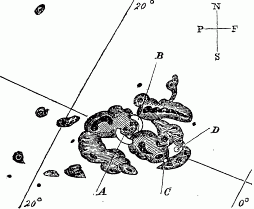
Article Excerpt:
Just before dawn the next day, skies all over planet Earth erupted in red, green, and purple auroras so brilliant that newspapers could be read as easily as in daylight. Indeed, stunning auroras pulsated even at near tropical latitudes over Cuba, the Bahamas, Jamaica, El Salvador, and Hawaii.
Even more disconcerting, telegraph systems worldwide went haywire. Spark discharges shocked telegraph operators and set the telegraph paper on fire. Even when telegraphers disconnected the batteries powering the lines, aurora-induced electric currents in the wires still allowed messages to be transmitted.
“What Carrington saw was a white-light solar flare—a magnetic explosion on the sun,” explains David Hathaway, solar physics team lead at NASA’s Marshall Space Flight Center in Huntsville, Alabama.
The explosion produced not only a surge of visible light but also a mammoth cloud of charged particles and detached magnetic loops—a “CME”—and hurled that cloud directly toward Earth. The next morning when the CME arrived, it crashed into Earth’s magnetic field, causing the global bubble of magnetism that surrounds our planet to shake and quiver. Researchers call this a “geomagnetic storm.” Rapidly moving fields induced enormous electric currents that surged through telegraph lines and disrupted communications.
Lanzerotti points out that as electronic technologies have become more sophisticated and more embedded into everyday life, they have also become more vulnerable to solar activity. On Earth, power lines and long-distance telephone cables might be affected by auroral currents, as happened in 1989. Radar, cell phone communications, and GPS receivers could be disrupted by solar radio noise. Experts who have studied the question say there is little to be done to protect satellites from a Carrington-class flare. In fact, a recent paper estimates potential damage to the 900-plus satellites currently in orbit could cost between $30 billion and $70 billion. The best solution, they say: have a pipeline of comsats ready for launch.
Analysis:
We have known about solar flares for hundreds of years, and understand that they can render even modern technology useless. These “Geomagnetic storms” of charged particles hit earth, disrupting our magnetic field and therefore our telecommunication systems. Even some recent surges in the past had affected GPS systems for a mere 10 minutes, which rendered certain GPS systems useless for this time.
Though plenty of research has been done and constant monitoring of the sun is underway, it seems as though we have not drafted up a concrete plan for if a solar flare will cause a mass power outage. This research and monitoring does take away the surprise factor of these events, however research alone will not prevent these from happening, and we must be prepared to act– to have a plan if something like this ever occurs.



